Report: Pacific People's Contribution to New Zealand Business
VerifiedAdded on 2023/06/07
|12
|3561
|313
Report
AI Summary
This report delves into the significant contributions of Pacific people to New Zealand's business environment. It begins by exploring the impact of historical events, specifically the Foreshore and Seabed Act of 2004, and its economic, social, and cultural implications, particularly for the Maori community. The report then highlights the achievements of prominent individuals from the Pacific community, such as Russell Crowe and Sir Peter Henry Buck, detailing their contributions to New Zealand society. Furthermore, it examines the role of the Pacific community in globalizing New Zealand's contemporary business sector, particularly through arts, literature, and music. The report concludes by discussing potential future social changes, such as those within the technology sector, and their likely impact on New Zealand society within the next decade. The analysis provides a comprehensive overview of the Pacific community's influence on New Zealand's development.
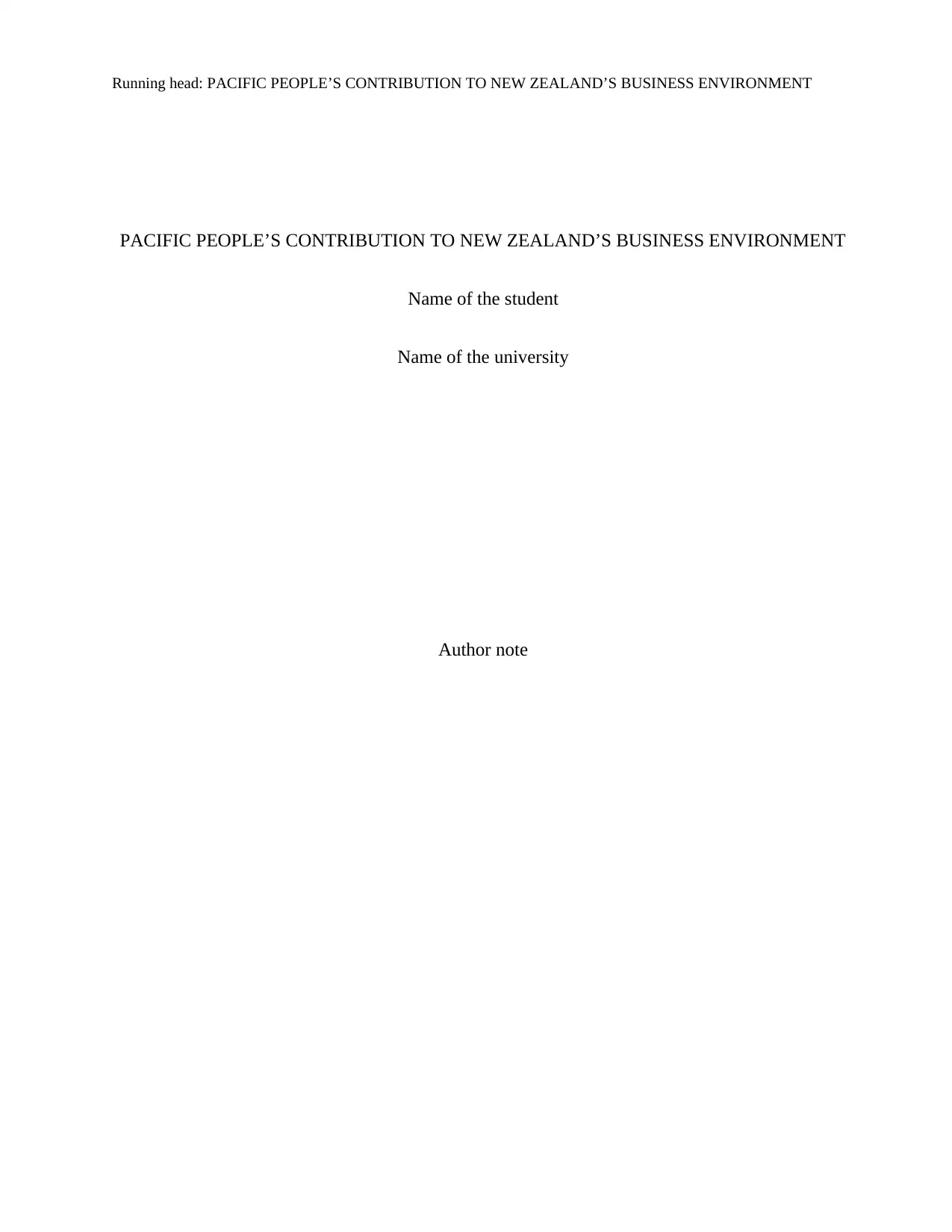
Running head: PACIFIC PEOPLE’S CONTRIBUTION TO NEW ZEALAND’S BUSINESS ENVIRONMENT
PACIFIC PEOPLE’S CONTRIBUTION TO NEW ZEALAND’S BUSINESS ENVIRONMENT
Name of the student
Name of the university
Author note
PACIFIC PEOPLE’S CONTRIBUTION TO NEW ZEALAND’S BUSINESS ENVIRONMENT
Name of the student
Name of the university
Author note
Paraphrase This Document
Need a fresh take? Get an instant paraphrase of this document with our AI Paraphraser
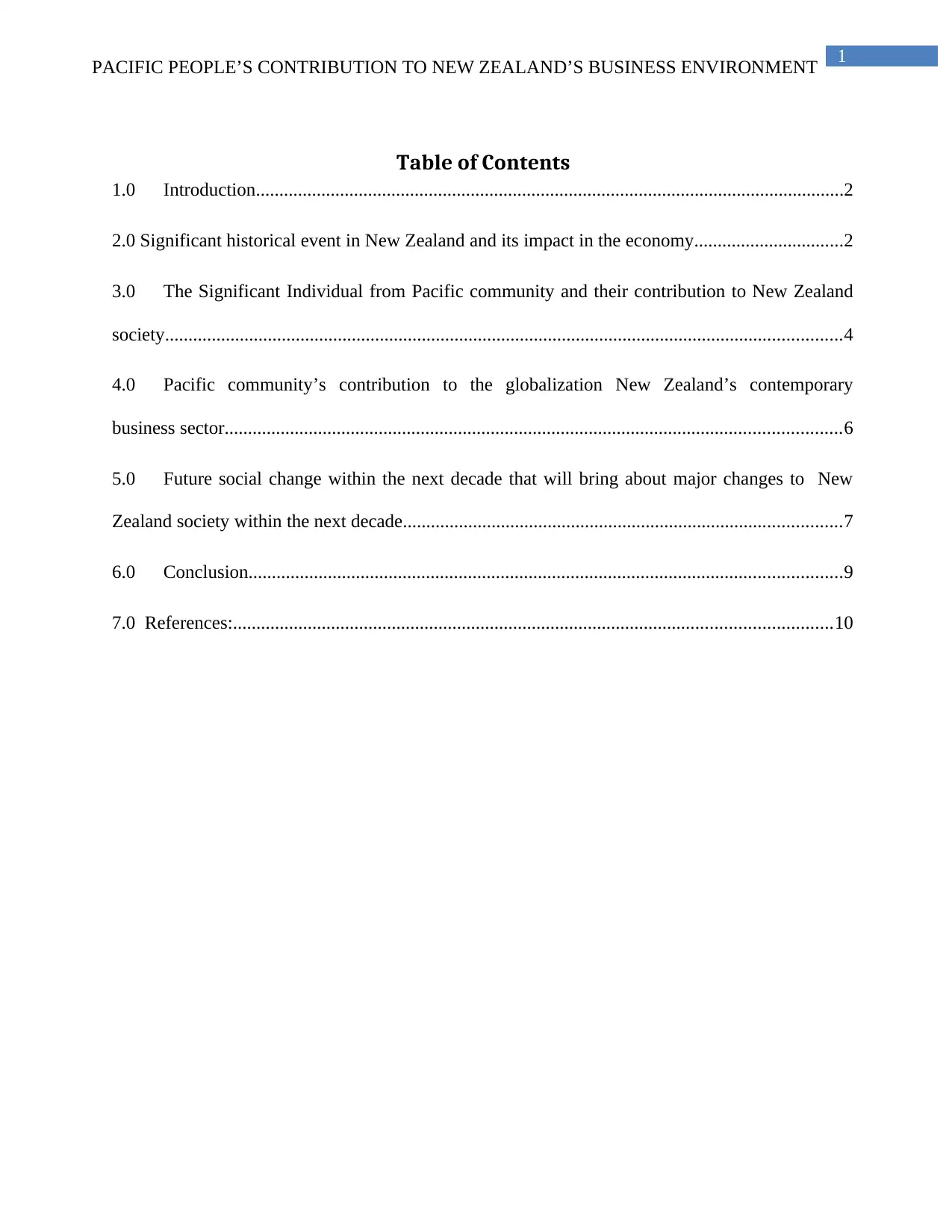
1
PACIFIC PEOPLE’S CONTRIBUTION TO NEW ZEALAND’S BUSINESS ENVIRONMENT
Table of Contents
1.0 Introduction..............................................................................................................................2
2.0 Significant historical event in New Zealand and its impact in the economy................................2
3.0 The Significant Individual from Pacific community and their contribution to New Zealand
society.................................................................................................................................................4
4.0 Pacific community’s contribution to the globalization New Zealand’s contemporary
business sector....................................................................................................................................6
5.0 Future social change within the next decade that will bring about major changes to New
Zealand society within the next decade..............................................................................................7
6.0 Conclusion...............................................................................................................................9
7.0 References:................................................................................................................................10
PACIFIC PEOPLE’S CONTRIBUTION TO NEW ZEALAND’S BUSINESS ENVIRONMENT
Table of Contents
1.0 Introduction..............................................................................................................................2
2.0 Significant historical event in New Zealand and its impact in the economy................................2
3.0 The Significant Individual from Pacific community and their contribution to New Zealand
society.................................................................................................................................................4
4.0 Pacific community’s contribution to the globalization New Zealand’s contemporary
business sector....................................................................................................................................6
5.0 Future social change within the next decade that will bring about major changes to New
Zealand society within the next decade..............................................................................................7
6.0 Conclusion...............................................................................................................................9
7.0 References:................................................................................................................................10
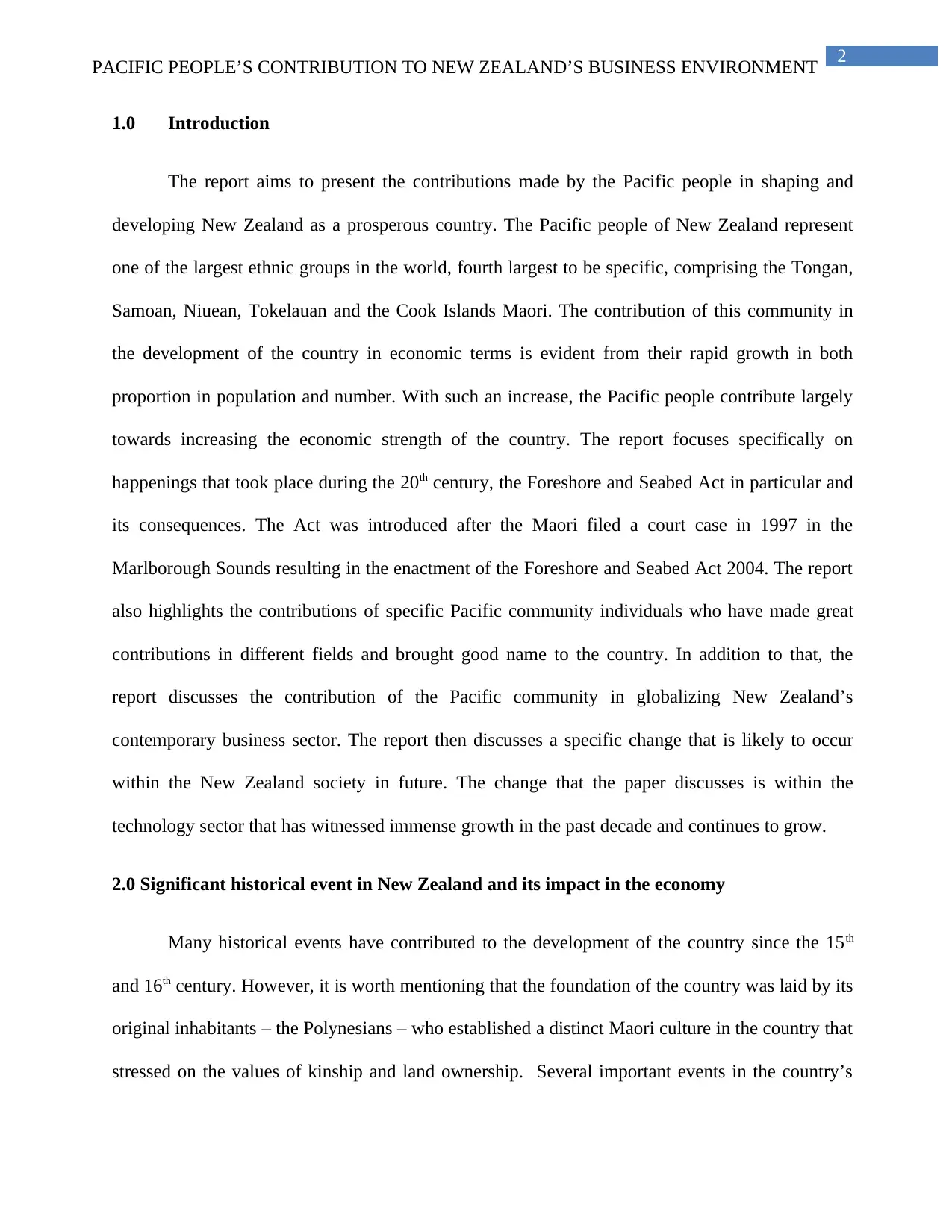
2
PACIFIC PEOPLE’S CONTRIBUTION TO NEW ZEALAND’S BUSINESS ENVIRONMENT
1.0 Introduction
The report aims to present the contributions made by the Pacific people in shaping and
developing New Zealand as a prosperous country. The Pacific people of New Zealand represent
one of the largest ethnic groups in the world, fourth largest to be specific, comprising the Tongan,
Samoan, Niuean, Tokelauan and the Cook Islands Maori. The contribution of this community in
the development of the country in economic terms is evident from their rapid growth in both
proportion in population and number. With such an increase, the Pacific people contribute largely
towards increasing the economic strength of the country. The report focuses specifically on
happenings that took place during the 20th century, the Foreshore and Seabed Act in particular and
its consequences. The Act was introduced after the Maori filed a court case in 1997 in the
Marlborough Sounds resulting in the enactment of the Foreshore and Seabed Act 2004. The report
also highlights the contributions of specific Pacific community individuals who have made great
contributions in different fields and brought good name to the country. In addition to that, the
report discusses the contribution of the Pacific community in globalizing New Zealand’s
contemporary business sector. The report then discusses a specific change that is likely to occur
within the New Zealand society in future. The change that the paper discusses is within the
technology sector that has witnessed immense growth in the past decade and continues to grow.
2.0 Significant historical event in New Zealand and its impact in the economy
Many historical events have contributed to the development of the country since the 15th
and 16th century. However, it is worth mentioning that the foundation of the country was laid by its
original inhabitants – the Polynesians – who established a distinct Maori culture in the country that
stressed on the values of kinship and land ownership. Several important events in the country’s
PACIFIC PEOPLE’S CONTRIBUTION TO NEW ZEALAND’S BUSINESS ENVIRONMENT
1.0 Introduction
The report aims to present the contributions made by the Pacific people in shaping and
developing New Zealand as a prosperous country. The Pacific people of New Zealand represent
one of the largest ethnic groups in the world, fourth largest to be specific, comprising the Tongan,
Samoan, Niuean, Tokelauan and the Cook Islands Maori. The contribution of this community in
the development of the country in economic terms is evident from their rapid growth in both
proportion in population and number. With such an increase, the Pacific people contribute largely
towards increasing the economic strength of the country. The report focuses specifically on
happenings that took place during the 20th century, the Foreshore and Seabed Act in particular and
its consequences. The Act was introduced after the Maori filed a court case in 1997 in the
Marlborough Sounds resulting in the enactment of the Foreshore and Seabed Act 2004. The report
also highlights the contributions of specific Pacific community individuals who have made great
contributions in different fields and brought good name to the country. In addition to that, the
report discusses the contribution of the Pacific community in globalizing New Zealand’s
contemporary business sector. The report then discusses a specific change that is likely to occur
within the New Zealand society in future. The change that the paper discusses is within the
technology sector that has witnessed immense growth in the past decade and continues to grow.
2.0 Significant historical event in New Zealand and its impact in the economy
Many historical events have contributed to the development of the country since the 15th
and 16th century. However, it is worth mentioning that the foundation of the country was laid by its
original inhabitants – the Polynesians – who established a distinct Maori culture in the country that
stressed on the values of kinship and land ownership. Several important events in the country’s
⊘ This is a preview!⊘
Do you want full access?
Subscribe today to unlock all pages.

Trusted by 1+ million students worldwide
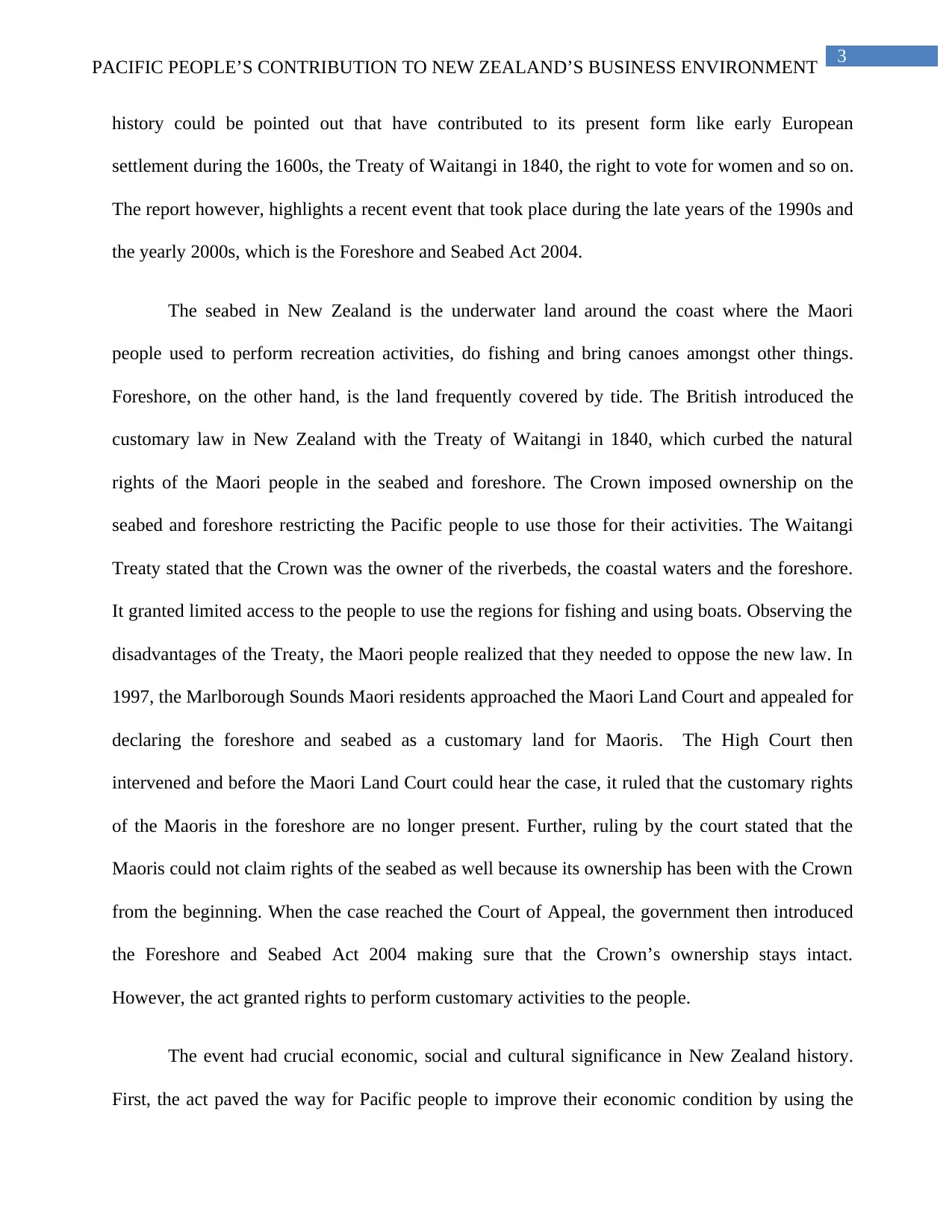
3
PACIFIC PEOPLE’S CONTRIBUTION TO NEW ZEALAND’S BUSINESS ENVIRONMENT
history could be pointed out that have contributed to its present form like early European
settlement during the 1600s, the Treaty of Waitangi in 1840, the right to vote for women and so on.
The report however, highlights a recent event that took place during the late years of the 1990s and
the yearly 2000s, which is the Foreshore and Seabed Act 2004.
The seabed in New Zealand is the underwater land around the coast where the Maori
people used to perform recreation activities, do fishing and bring canoes amongst other things.
Foreshore, on the other hand, is the land frequently covered by tide. The British introduced the
customary law in New Zealand with the Treaty of Waitangi in 1840, which curbed the natural
rights of the Maori people in the seabed and foreshore. The Crown imposed ownership on the
seabed and foreshore restricting the Pacific people to use those for their activities. The Waitangi
Treaty stated that the Crown was the owner of the riverbeds, the coastal waters and the foreshore.
It granted limited access to the people to use the regions for fishing and using boats. Observing the
disadvantages of the Treaty, the Maori people realized that they needed to oppose the new law. In
1997, the Marlborough Sounds Maori residents approached the Maori Land Court and appealed for
declaring the foreshore and seabed as a customary land for Maoris. The High Court then
intervened and before the Maori Land Court could hear the case, it ruled that the customary rights
of the Maoris in the foreshore are no longer present. Further, ruling by the court stated that the
Maoris could not claim rights of the seabed as well because its ownership has been with the Crown
from the beginning. When the case reached the Court of Appeal, the government then introduced
the Foreshore and Seabed Act 2004 making sure that the Crown’s ownership stays intact.
However, the act granted rights to perform customary activities to the people.
The event had crucial economic, social and cultural significance in New Zealand history.
First, the act paved the way for Pacific people to improve their economic condition by using the
PACIFIC PEOPLE’S CONTRIBUTION TO NEW ZEALAND’S BUSINESS ENVIRONMENT
history could be pointed out that have contributed to its present form like early European
settlement during the 1600s, the Treaty of Waitangi in 1840, the right to vote for women and so on.
The report however, highlights a recent event that took place during the late years of the 1990s and
the yearly 2000s, which is the Foreshore and Seabed Act 2004.
The seabed in New Zealand is the underwater land around the coast where the Maori
people used to perform recreation activities, do fishing and bring canoes amongst other things.
Foreshore, on the other hand, is the land frequently covered by tide. The British introduced the
customary law in New Zealand with the Treaty of Waitangi in 1840, which curbed the natural
rights of the Maori people in the seabed and foreshore. The Crown imposed ownership on the
seabed and foreshore restricting the Pacific people to use those for their activities. The Waitangi
Treaty stated that the Crown was the owner of the riverbeds, the coastal waters and the foreshore.
It granted limited access to the people to use the regions for fishing and using boats. Observing the
disadvantages of the Treaty, the Maori people realized that they needed to oppose the new law. In
1997, the Marlborough Sounds Maori residents approached the Maori Land Court and appealed for
declaring the foreshore and seabed as a customary land for Maoris. The High Court then
intervened and before the Maori Land Court could hear the case, it ruled that the customary rights
of the Maoris in the foreshore are no longer present. Further, ruling by the court stated that the
Maoris could not claim rights of the seabed as well because its ownership has been with the Crown
from the beginning. When the case reached the Court of Appeal, the government then introduced
the Foreshore and Seabed Act 2004 making sure that the Crown’s ownership stays intact.
However, the act granted rights to perform customary activities to the people.
The event had crucial economic, social and cultural significance in New Zealand history.
First, the act paved the way for Pacific people to improve their economic condition by using the
Paraphrase This Document
Need a fresh take? Get an instant paraphrase of this document with our AI Paraphraser
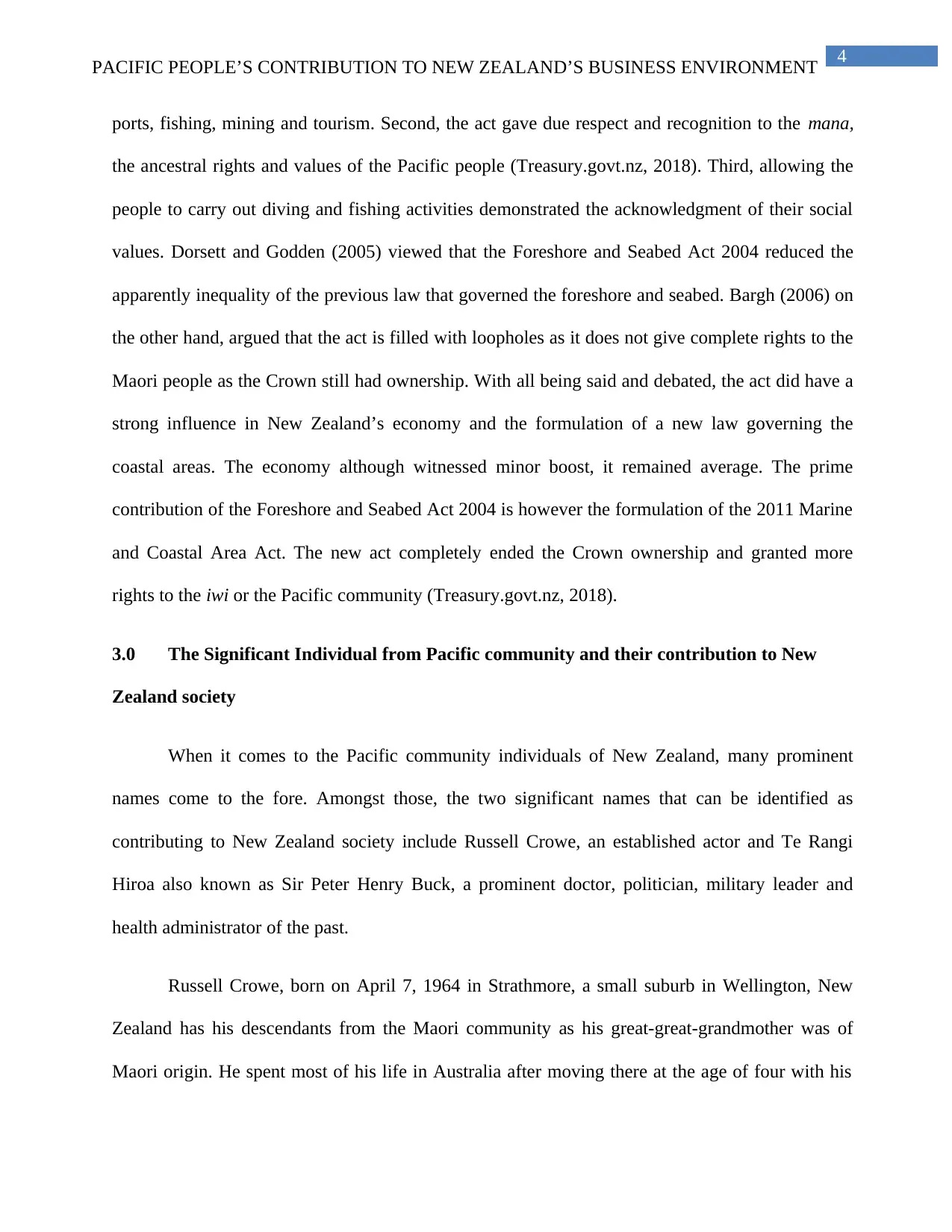
4
PACIFIC PEOPLE’S CONTRIBUTION TO NEW ZEALAND’S BUSINESS ENVIRONMENT
ports, fishing, mining and tourism. Second, the act gave due respect and recognition to the mana,
the ancestral rights and values of the Pacific people (Treasury.govt.nz, 2018). Third, allowing the
people to carry out diving and fishing activities demonstrated the acknowledgment of their social
values. Dorsett and Godden (2005) viewed that the Foreshore and Seabed Act 2004 reduced the
apparently inequality of the previous law that governed the foreshore and seabed. Bargh (2006) on
the other hand, argued that the act is filled with loopholes as it does not give complete rights to the
Maori people as the Crown still had ownership. With all being said and debated, the act did have a
strong influence in New Zealand’s economy and the formulation of a new law governing the
coastal areas. The economy although witnessed minor boost, it remained average. The prime
contribution of the Foreshore and Seabed Act 2004 is however the formulation of the 2011 Marine
and Coastal Area Act. The new act completely ended the Crown ownership and granted more
rights to the iwi or the Pacific community (Treasury.govt.nz, 2018).
3.0 The Significant Individual from Pacific community and their contribution to New
Zealand society
When it comes to the Pacific community individuals of New Zealand, many prominent
names come to the fore. Amongst those, the two significant names that can be identified as
contributing to New Zealand society include Russell Crowe, an established actor and Te Rangi
Hiroa also known as Sir Peter Henry Buck, a prominent doctor, politician, military leader and
health administrator of the past.
Russell Crowe, born on April 7, 1964 in Strathmore, a small suburb in Wellington, New
Zealand has his descendants from the Maori community as his great-great-grandmother was of
Maori origin. He spent most of his life in Australia after moving there at the age of four with his
PACIFIC PEOPLE’S CONTRIBUTION TO NEW ZEALAND’S BUSINESS ENVIRONMENT
ports, fishing, mining and tourism. Second, the act gave due respect and recognition to the mana,
the ancestral rights and values of the Pacific people (Treasury.govt.nz, 2018). Third, allowing the
people to carry out diving and fishing activities demonstrated the acknowledgment of their social
values. Dorsett and Godden (2005) viewed that the Foreshore and Seabed Act 2004 reduced the
apparently inequality of the previous law that governed the foreshore and seabed. Bargh (2006) on
the other hand, argued that the act is filled with loopholes as it does not give complete rights to the
Maori people as the Crown still had ownership. With all being said and debated, the act did have a
strong influence in New Zealand’s economy and the formulation of a new law governing the
coastal areas. The economy although witnessed minor boost, it remained average. The prime
contribution of the Foreshore and Seabed Act 2004 is however the formulation of the 2011 Marine
and Coastal Area Act. The new act completely ended the Crown ownership and granted more
rights to the iwi or the Pacific community (Treasury.govt.nz, 2018).
3.0 The Significant Individual from Pacific community and their contribution to New
Zealand society
When it comes to the Pacific community individuals of New Zealand, many prominent
names come to the fore. Amongst those, the two significant names that can be identified as
contributing to New Zealand society include Russell Crowe, an established actor and Te Rangi
Hiroa also known as Sir Peter Henry Buck, a prominent doctor, politician, military leader and
health administrator of the past.
Russell Crowe, born on April 7, 1964 in Strathmore, a small suburb in Wellington, New
Zealand has his descendants from the Maori community as his great-great-grandmother was of
Maori origin. He spent most of his life in Australia after moving there at the age of four with his
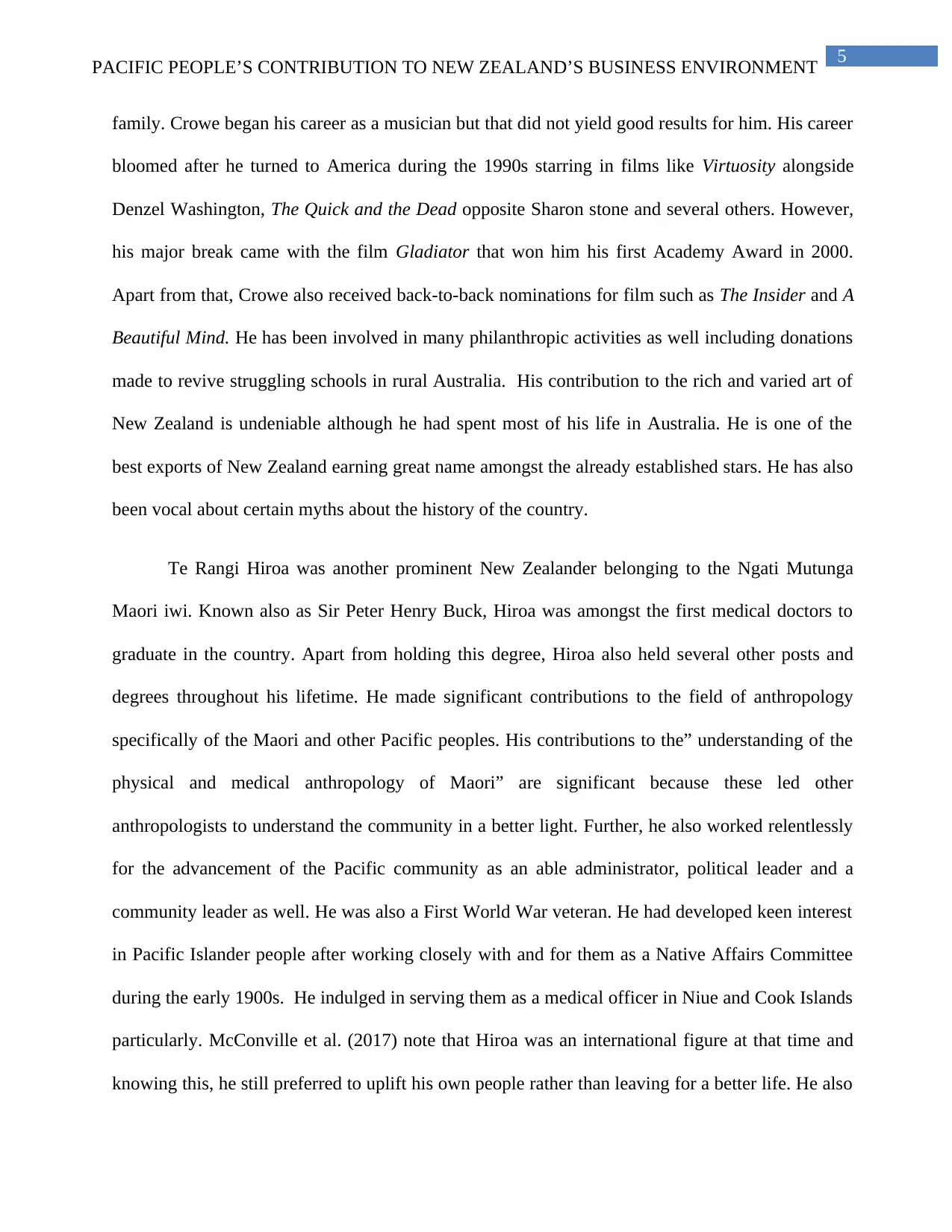
5
PACIFIC PEOPLE’S CONTRIBUTION TO NEW ZEALAND’S BUSINESS ENVIRONMENT
family. Crowe began his career as a musician but that did not yield good results for him. His career
bloomed after he turned to America during the 1990s starring in films like Virtuosity alongside
Denzel Washington, The Quick and the Dead opposite Sharon stone and several others. However,
his major break came with the film Gladiator that won him his first Academy Award in 2000.
Apart from that, Crowe also received back-to-back nominations for film such as The Insider and A
Beautiful Mind. He has been involved in many philanthropic activities as well including donations
made to revive struggling schools in rural Australia. His contribution to the rich and varied art of
New Zealand is undeniable although he had spent most of his life in Australia. He is one of the
best exports of New Zealand earning great name amongst the already established stars. He has also
been vocal about certain myths about the history of the country.
Te Rangi Hiroa was another prominent New Zealander belonging to the Ngati Mutunga
Maori iwi. Known also as Sir Peter Henry Buck, Hiroa was amongst the first medical doctors to
graduate in the country. Apart from holding this degree, Hiroa also held several other posts and
degrees throughout his lifetime. He made significant contributions to the field of anthropology
specifically of the Maori and other Pacific peoples. His contributions to the” understanding of the
physical and medical anthropology of Maori” are significant because these led other
anthropologists to understand the community in a better light. Further, he also worked relentlessly
for the advancement of the Pacific community as an able administrator, political leader and a
community leader as well. He was also a First World War veteran. He had developed keen interest
in Pacific Islander people after working closely with and for them as a Native Affairs Committee
during the early 1900s. He indulged in serving them as a medical officer in Niue and Cook Islands
particularly. McConville et al. (2017) note that Hiroa was an international figure at that time and
knowing this, he still preferred to uplift his own people rather than leaving for a better life. He also
PACIFIC PEOPLE’S CONTRIBUTION TO NEW ZEALAND’S BUSINESS ENVIRONMENT
family. Crowe began his career as a musician but that did not yield good results for him. His career
bloomed after he turned to America during the 1990s starring in films like Virtuosity alongside
Denzel Washington, The Quick and the Dead opposite Sharon stone and several others. However,
his major break came with the film Gladiator that won him his first Academy Award in 2000.
Apart from that, Crowe also received back-to-back nominations for film such as The Insider and A
Beautiful Mind. He has been involved in many philanthropic activities as well including donations
made to revive struggling schools in rural Australia. His contribution to the rich and varied art of
New Zealand is undeniable although he had spent most of his life in Australia. He is one of the
best exports of New Zealand earning great name amongst the already established stars. He has also
been vocal about certain myths about the history of the country.
Te Rangi Hiroa was another prominent New Zealander belonging to the Ngati Mutunga
Maori iwi. Known also as Sir Peter Henry Buck, Hiroa was amongst the first medical doctors to
graduate in the country. Apart from holding this degree, Hiroa also held several other posts and
degrees throughout his lifetime. He made significant contributions to the field of anthropology
specifically of the Maori and other Pacific peoples. His contributions to the” understanding of the
physical and medical anthropology of Maori” are significant because these led other
anthropologists to understand the community in a better light. Further, he also worked relentlessly
for the advancement of the Pacific community as an able administrator, political leader and a
community leader as well. He was also a First World War veteran. He had developed keen interest
in Pacific Islander people after working closely with and for them as a Native Affairs Committee
during the early 1900s. He indulged in serving them as a medical officer in Niue and Cook Islands
particularly. McConville et al. (2017) note that Hiroa was an international figure at that time and
knowing this, he still preferred to uplift his own people rather than leaving for a better life. He also
⊘ This is a preview!⊘
Do you want full access?
Subscribe today to unlock all pages.

Trusted by 1+ million students worldwide
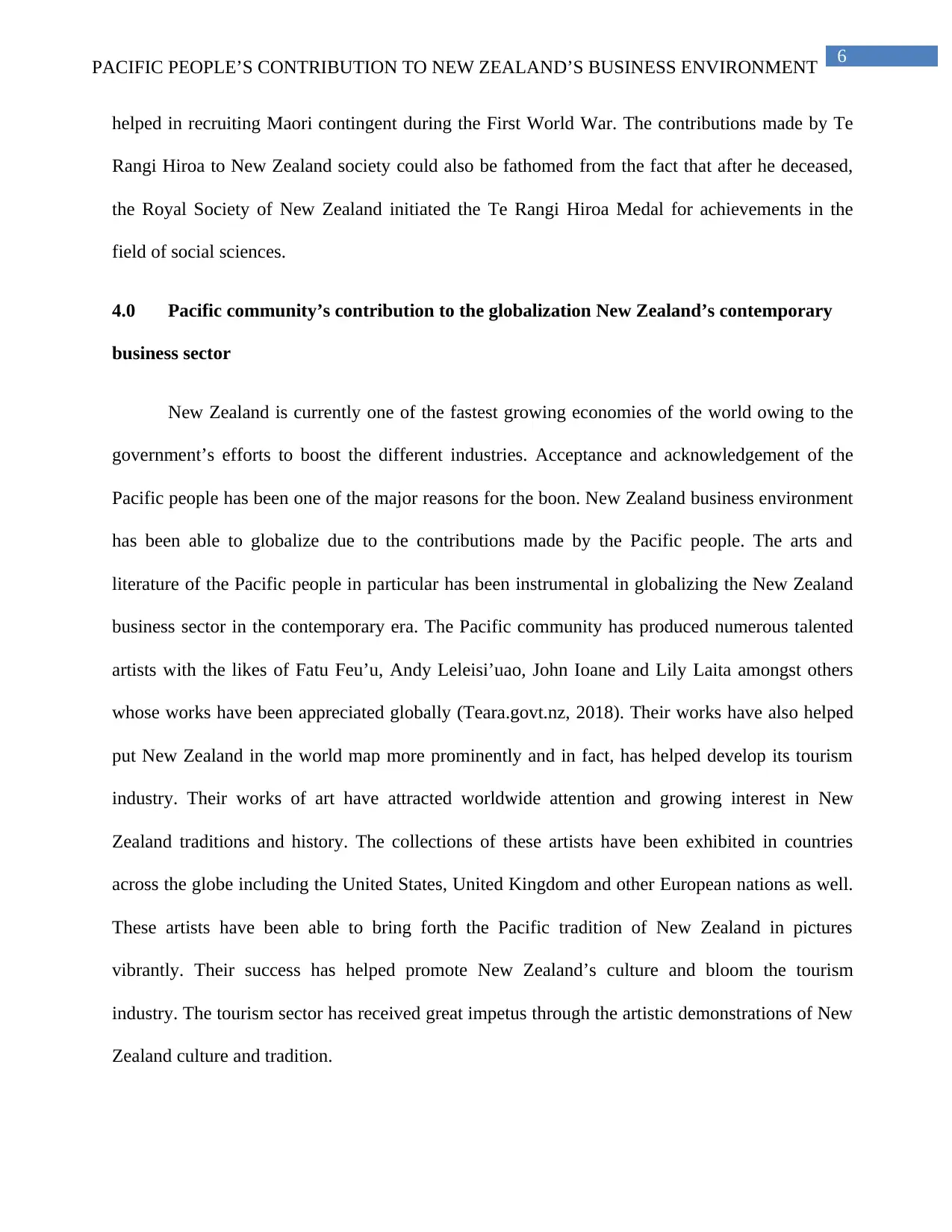
6
PACIFIC PEOPLE’S CONTRIBUTION TO NEW ZEALAND’S BUSINESS ENVIRONMENT
helped in recruiting Maori contingent during the First World War. The contributions made by Te
Rangi Hiroa to New Zealand society could also be fathomed from the fact that after he deceased,
the Royal Society of New Zealand initiated the Te Rangi Hiroa Medal for achievements in the
field of social sciences.
4.0 Pacific community’s contribution to the globalization New Zealand’s contemporary
business sector
New Zealand is currently one of the fastest growing economies of the world owing to the
government’s efforts to boost the different industries. Acceptance and acknowledgement of the
Pacific people has been one of the major reasons for the boon. New Zealand business environment
has been able to globalize due to the contributions made by the Pacific people. The arts and
literature of the Pacific people in particular has been instrumental in globalizing the New Zealand
business sector in the contemporary era. The Pacific community has produced numerous talented
artists with the likes of Fatu Feu’u, Andy Leleisi’uao, John Ioane and Lily Laita amongst others
whose works have been appreciated globally (Teara.govt.nz, 2018). Their works have also helped
put New Zealand in the world map more prominently and in fact, has helped develop its tourism
industry. Their works of art have attracted worldwide attention and growing interest in New
Zealand traditions and history. The collections of these artists have been exhibited in countries
across the globe including the United States, United Kingdom and other European nations as well.
These artists have been able to bring forth the Pacific tradition of New Zealand in pictures
vibrantly. Their success has helped promote New Zealand’s culture and bloom the tourism
industry. The tourism sector has received great impetus through the artistic demonstrations of New
Zealand culture and tradition.
PACIFIC PEOPLE’S CONTRIBUTION TO NEW ZEALAND’S BUSINESS ENVIRONMENT
helped in recruiting Maori contingent during the First World War. The contributions made by Te
Rangi Hiroa to New Zealand society could also be fathomed from the fact that after he deceased,
the Royal Society of New Zealand initiated the Te Rangi Hiroa Medal for achievements in the
field of social sciences.
4.0 Pacific community’s contribution to the globalization New Zealand’s contemporary
business sector
New Zealand is currently one of the fastest growing economies of the world owing to the
government’s efforts to boost the different industries. Acceptance and acknowledgement of the
Pacific people has been one of the major reasons for the boon. New Zealand business environment
has been able to globalize due to the contributions made by the Pacific people. The arts and
literature of the Pacific people in particular has been instrumental in globalizing the New Zealand
business sector in the contemporary era. The Pacific community has produced numerous talented
artists with the likes of Fatu Feu’u, Andy Leleisi’uao, John Ioane and Lily Laita amongst others
whose works have been appreciated globally (Teara.govt.nz, 2018). Their works have also helped
put New Zealand in the world map more prominently and in fact, has helped develop its tourism
industry. Their works of art have attracted worldwide attention and growing interest in New
Zealand traditions and history. The collections of these artists have been exhibited in countries
across the globe including the United States, United Kingdom and other European nations as well.
These artists have been able to bring forth the Pacific tradition of New Zealand in pictures
vibrantly. Their success has helped promote New Zealand’s culture and bloom the tourism
industry. The tourism sector has received great impetus through the artistic demonstrations of New
Zealand culture and tradition.
Paraphrase This Document
Need a fresh take? Get an instant paraphrase of this document with our AI Paraphraser
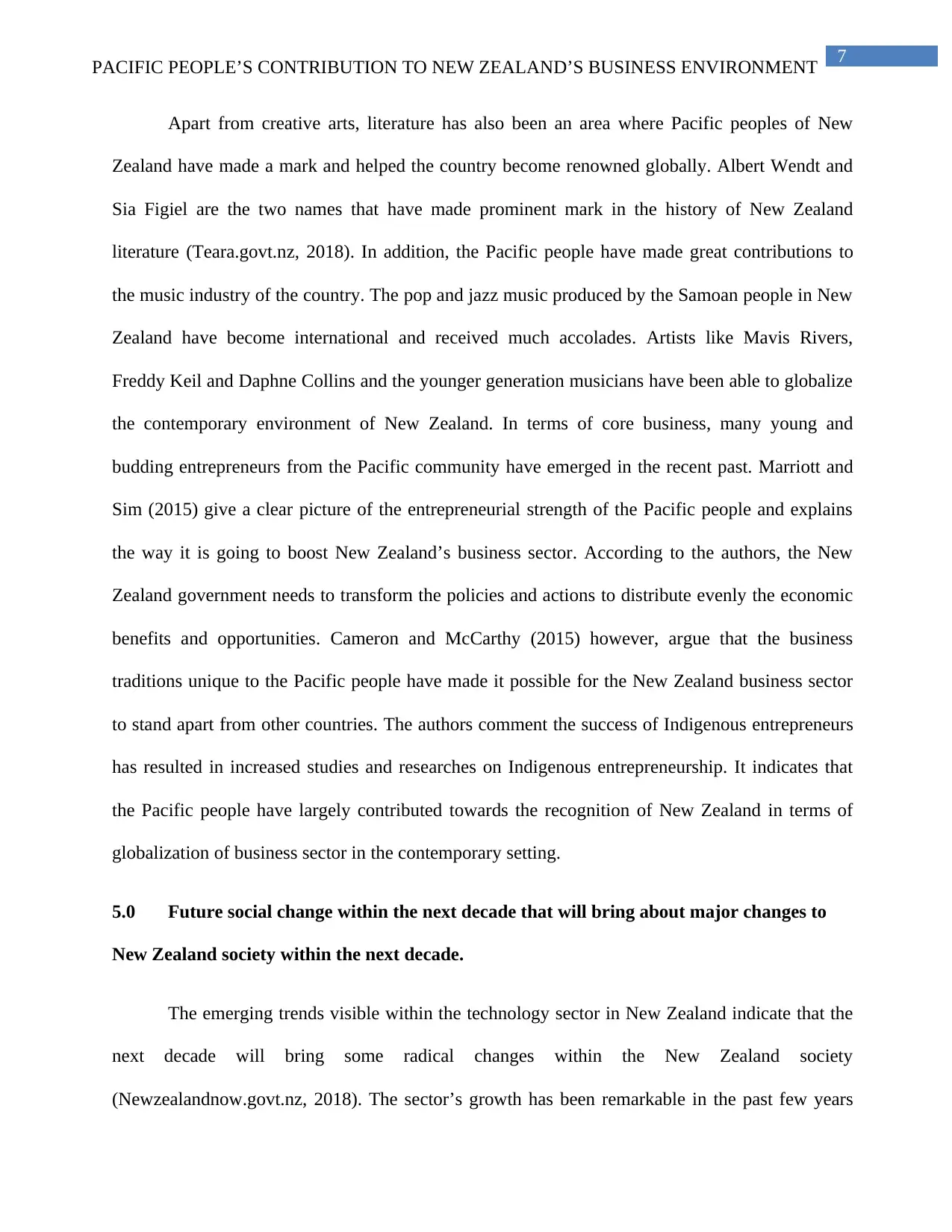
7
PACIFIC PEOPLE’S CONTRIBUTION TO NEW ZEALAND’S BUSINESS ENVIRONMENT
Apart from creative arts, literature has also been an area where Pacific peoples of New
Zealand have made a mark and helped the country become renowned globally. Albert Wendt and
Sia Figiel are the two names that have made prominent mark in the history of New Zealand
literature (Teara.govt.nz, 2018). In addition, the Pacific people have made great contributions to
the music industry of the country. The pop and jazz music produced by the Samoan people in New
Zealand have become international and received much accolades. Artists like Mavis Rivers,
Freddy Keil and Daphne Collins and the younger generation musicians have been able to globalize
the contemporary environment of New Zealand. In terms of core business, many young and
budding entrepreneurs from the Pacific community have emerged in the recent past. Marriott and
Sim (2015) give a clear picture of the entrepreneurial strength of the Pacific people and explains
the way it is going to boost New Zealand’s business sector. According to the authors, the New
Zealand government needs to transform the policies and actions to distribute evenly the economic
benefits and opportunities. Cameron and McCarthy (2015) however, argue that the business
traditions unique to the Pacific people have made it possible for the New Zealand business sector
to stand apart from other countries. The authors comment the success of Indigenous entrepreneurs
has resulted in increased studies and researches on Indigenous entrepreneurship. It indicates that
the Pacific people have largely contributed towards the recognition of New Zealand in terms of
globalization of business sector in the contemporary setting.
5.0 Future social change within the next decade that will bring about major changes to
New Zealand society within the next decade.
The emerging trends visible within the technology sector in New Zealand indicate that the
next decade will bring some radical changes within the New Zealand society
(Newzealandnow.govt.nz, 2018). The sector’s growth has been remarkable in the past few years
PACIFIC PEOPLE’S CONTRIBUTION TO NEW ZEALAND’S BUSINESS ENVIRONMENT
Apart from creative arts, literature has also been an area where Pacific peoples of New
Zealand have made a mark and helped the country become renowned globally. Albert Wendt and
Sia Figiel are the two names that have made prominent mark in the history of New Zealand
literature (Teara.govt.nz, 2018). In addition, the Pacific people have made great contributions to
the music industry of the country. The pop and jazz music produced by the Samoan people in New
Zealand have become international and received much accolades. Artists like Mavis Rivers,
Freddy Keil and Daphne Collins and the younger generation musicians have been able to globalize
the contemporary environment of New Zealand. In terms of core business, many young and
budding entrepreneurs from the Pacific community have emerged in the recent past. Marriott and
Sim (2015) give a clear picture of the entrepreneurial strength of the Pacific people and explains
the way it is going to boost New Zealand’s business sector. According to the authors, the New
Zealand government needs to transform the policies and actions to distribute evenly the economic
benefits and opportunities. Cameron and McCarthy (2015) however, argue that the business
traditions unique to the Pacific people have made it possible for the New Zealand business sector
to stand apart from other countries. The authors comment the success of Indigenous entrepreneurs
has resulted in increased studies and researches on Indigenous entrepreneurship. It indicates that
the Pacific people have largely contributed towards the recognition of New Zealand in terms of
globalization of business sector in the contemporary setting.
5.0 Future social change within the next decade that will bring about major changes to
New Zealand society within the next decade.
The emerging trends visible within the technology sector in New Zealand indicate that the
next decade will bring some radical changes within the New Zealand society
(Newzealandnow.govt.nz, 2018). The sector’s growth has been remarkable in the past few years
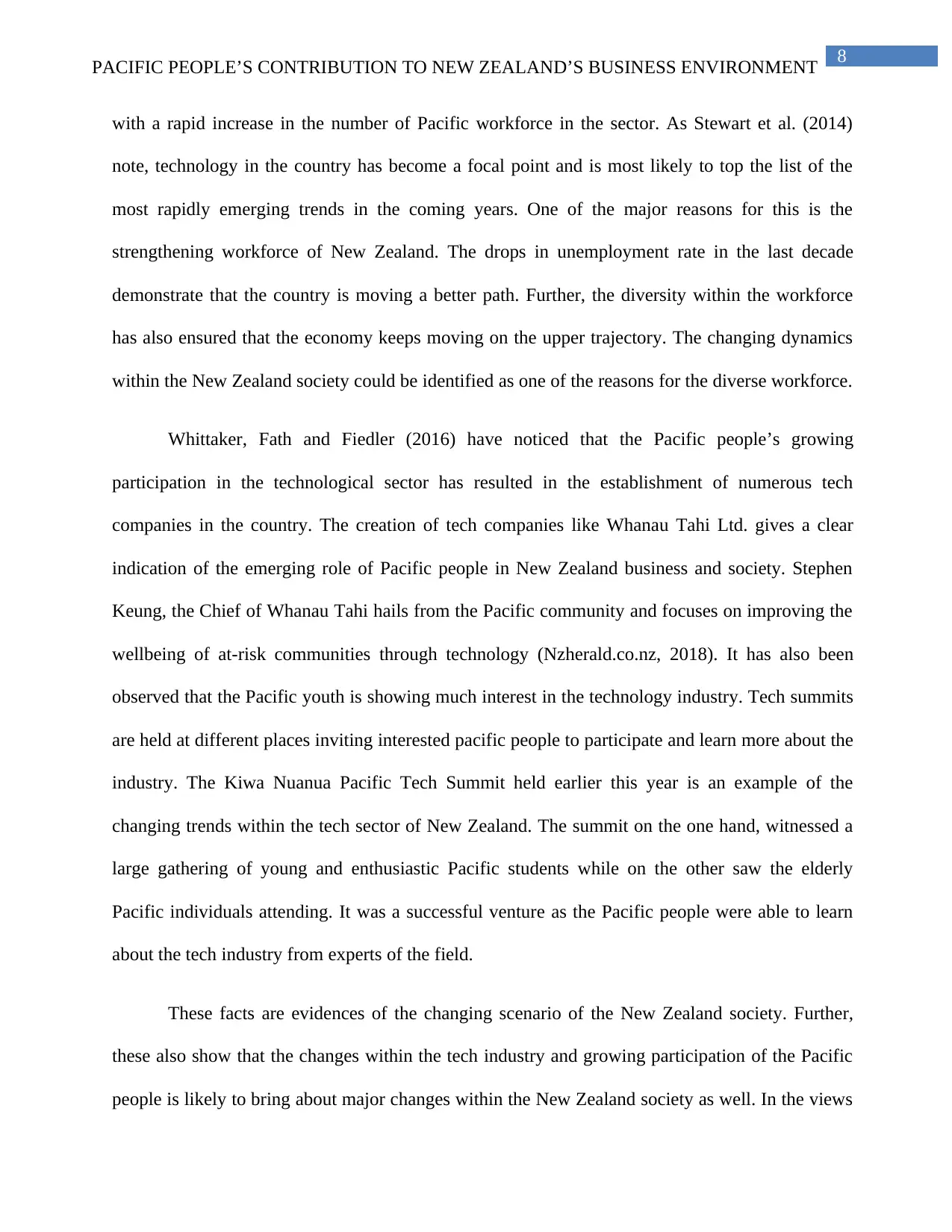
8
PACIFIC PEOPLE’S CONTRIBUTION TO NEW ZEALAND’S BUSINESS ENVIRONMENT
with a rapid increase in the number of Pacific workforce in the sector. As Stewart et al. (2014)
note, technology in the country has become a focal point and is most likely to top the list of the
most rapidly emerging trends in the coming years. One of the major reasons for this is the
strengthening workforce of New Zealand. The drops in unemployment rate in the last decade
demonstrate that the country is moving a better path. Further, the diversity within the workforce
has also ensured that the economy keeps moving on the upper trajectory. The changing dynamics
within the New Zealand society could be identified as one of the reasons for the diverse workforce.
Whittaker, Fath and Fiedler (2016) have noticed that the Pacific people’s growing
participation in the technological sector has resulted in the establishment of numerous tech
companies in the country. The creation of tech companies like Whanau Tahi Ltd. gives a clear
indication of the emerging role of Pacific people in New Zealand business and society. Stephen
Keung, the Chief of Whanau Tahi hails from the Pacific community and focuses on improving the
wellbeing of at-risk communities through technology (Nzherald.co.nz, 2018). It has also been
observed that the Pacific youth is showing much interest in the technology industry. Tech summits
are held at different places inviting interested pacific people to participate and learn more about the
industry. The Kiwa Nuanua Pacific Tech Summit held earlier this year is an example of the
changing trends within the tech sector of New Zealand. The summit on the one hand, witnessed a
large gathering of young and enthusiastic Pacific students while on the other saw the elderly
Pacific individuals attending. It was a successful venture as the Pacific people were able to learn
about the tech industry from experts of the field.
These facts are evidences of the changing scenario of the New Zealand society. Further,
these also show that the changes within the tech industry and growing participation of the Pacific
people is likely to bring about major changes within the New Zealand society as well. In the views
PACIFIC PEOPLE’S CONTRIBUTION TO NEW ZEALAND’S BUSINESS ENVIRONMENT
with a rapid increase in the number of Pacific workforce in the sector. As Stewart et al. (2014)
note, technology in the country has become a focal point and is most likely to top the list of the
most rapidly emerging trends in the coming years. One of the major reasons for this is the
strengthening workforce of New Zealand. The drops in unemployment rate in the last decade
demonstrate that the country is moving a better path. Further, the diversity within the workforce
has also ensured that the economy keeps moving on the upper trajectory. The changing dynamics
within the New Zealand society could be identified as one of the reasons for the diverse workforce.
Whittaker, Fath and Fiedler (2016) have noticed that the Pacific people’s growing
participation in the technological sector has resulted in the establishment of numerous tech
companies in the country. The creation of tech companies like Whanau Tahi Ltd. gives a clear
indication of the emerging role of Pacific people in New Zealand business and society. Stephen
Keung, the Chief of Whanau Tahi hails from the Pacific community and focuses on improving the
wellbeing of at-risk communities through technology (Nzherald.co.nz, 2018). It has also been
observed that the Pacific youth is showing much interest in the technology industry. Tech summits
are held at different places inviting interested pacific people to participate and learn more about the
industry. The Kiwa Nuanua Pacific Tech Summit held earlier this year is an example of the
changing trends within the tech sector of New Zealand. The summit on the one hand, witnessed a
large gathering of young and enthusiastic Pacific students while on the other saw the elderly
Pacific individuals attending. It was a successful venture as the Pacific people were able to learn
about the tech industry from experts of the field.
These facts are evidences of the changing scenario of the New Zealand society. Further,
these also show that the changes within the tech industry and growing participation of the Pacific
people is likely to bring about major changes within the New Zealand society as well. In the views
⊘ This is a preview!⊘
Do you want full access?
Subscribe today to unlock all pages.

Trusted by 1+ million students worldwide
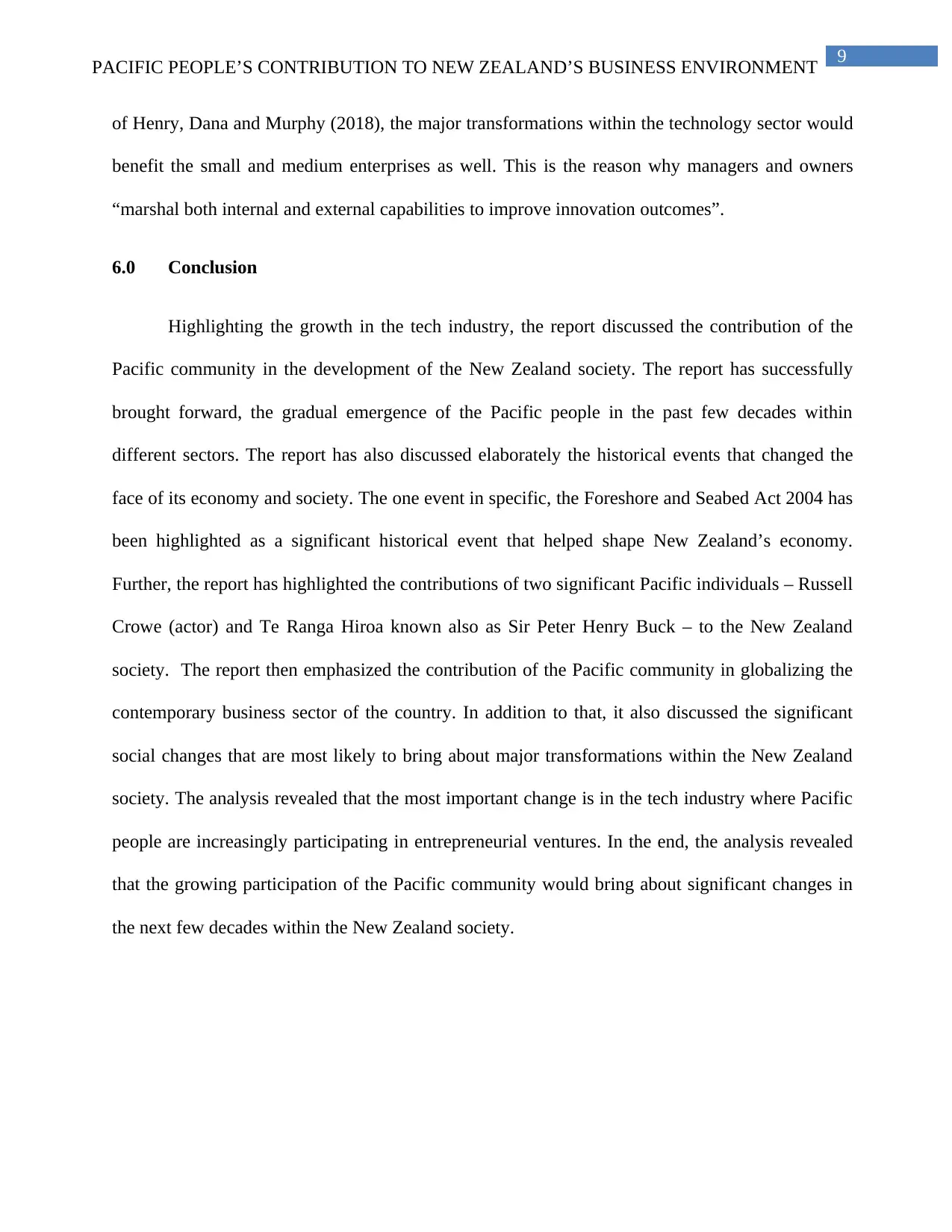
9
PACIFIC PEOPLE’S CONTRIBUTION TO NEW ZEALAND’S BUSINESS ENVIRONMENT
of Henry, Dana and Murphy (2018), the major transformations within the technology sector would
benefit the small and medium enterprises as well. This is the reason why managers and owners
“marshal both internal and external capabilities to improve innovation outcomes”.
6.0 Conclusion
Highlighting the growth in the tech industry, the report discussed the contribution of the
Pacific community in the development of the New Zealand society. The report has successfully
brought forward, the gradual emergence of the Pacific people in the past few decades within
different sectors. The report has also discussed elaborately the historical events that changed the
face of its economy and society. The one event in specific, the Foreshore and Seabed Act 2004 has
been highlighted as a significant historical event that helped shape New Zealand’s economy.
Further, the report has highlighted the contributions of two significant Pacific individuals – Russell
Crowe (actor) and Te Ranga Hiroa known also as Sir Peter Henry Buck – to the New Zealand
society. The report then emphasized the contribution of the Pacific community in globalizing the
contemporary business sector of the country. In addition to that, it also discussed the significant
social changes that are most likely to bring about major transformations within the New Zealand
society. The analysis revealed that the most important change is in the tech industry where Pacific
people are increasingly participating in entrepreneurial ventures. In the end, the analysis revealed
that the growing participation of the Pacific community would bring about significant changes in
the next few decades within the New Zealand society.
PACIFIC PEOPLE’S CONTRIBUTION TO NEW ZEALAND’S BUSINESS ENVIRONMENT
of Henry, Dana and Murphy (2018), the major transformations within the technology sector would
benefit the small and medium enterprises as well. This is the reason why managers and owners
“marshal both internal and external capabilities to improve innovation outcomes”.
6.0 Conclusion
Highlighting the growth in the tech industry, the report discussed the contribution of the
Pacific community in the development of the New Zealand society. The report has successfully
brought forward, the gradual emergence of the Pacific people in the past few decades within
different sectors. The report has also discussed elaborately the historical events that changed the
face of its economy and society. The one event in specific, the Foreshore and Seabed Act 2004 has
been highlighted as a significant historical event that helped shape New Zealand’s economy.
Further, the report has highlighted the contributions of two significant Pacific individuals – Russell
Crowe (actor) and Te Ranga Hiroa known also as Sir Peter Henry Buck – to the New Zealand
society. The report then emphasized the contribution of the Pacific community in globalizing the
contemporary business sector of the country. In addition to that, it also discussed the significant
social changes that are most likely to bring about major transformations within the New Zealand
society. The analysis revealed that the most important change is in the tech industry where Pacific
people are increasingly participating in entrepreneurial ventures. In the end, the analysis revealed
that the growing participation of the Pacific community would bring about significant changes in
the next few decades within the New Zealand society.
Paraphrase This Document
Need a fresh take? Get an instant paraphrase of this document with our AI Paraphraser
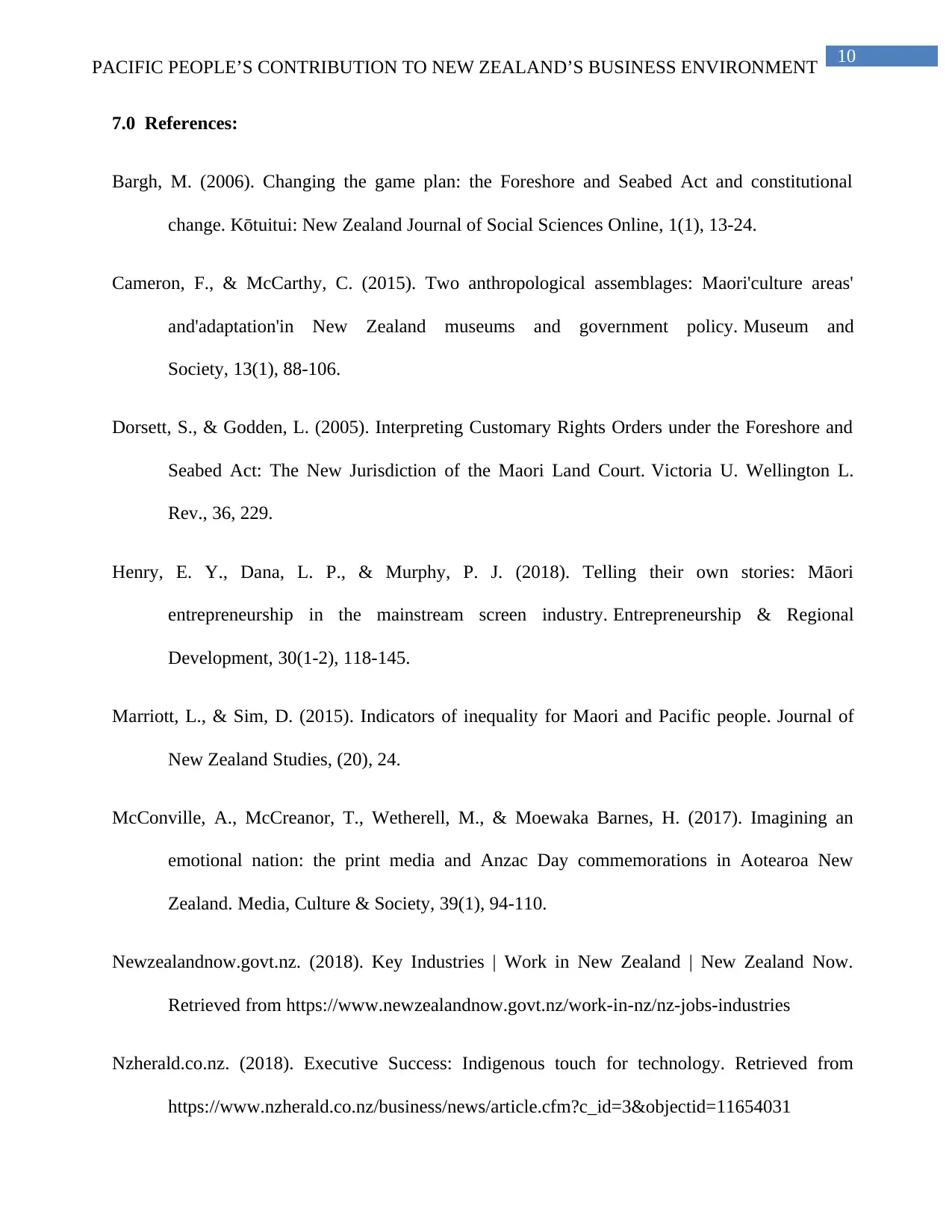
10
PACIFIC PEOPLE’S CONTRIBUTION TO NEW ZEALAND’S BUSINESS ENVIRONMENT
7.0 References:
Bargh, M. (2006). Changing the game plan: the Foreshore and Seabed Act and constitutional
change. Kōtuitui: New Zealand Journal of Social Sciences Online, 1(1), 13-24.
Cameron, F., & McCarthy, C. (2015). Two anthropological assemblages: Maori'culture areas'
and'adaptation'in New Zealand museums and government policy. Museum and
Society, 13(1), 88-106.
Dorsett, S., & Godden, L. (2005). Interpreting Customary Rights Orders under the Foreshore and
Seabed Act: The New Jurisdiction of the Maori Land Court. Victoria U. Wellington L.
Rev., 36, 229.
Henry, E. Y., Dana, L. P., & Murphy, P. J. (2018). Telling their own stories: Māori
entrepreneurship in the mainstream screen industry. Entrepreneurship & Regional
Development, 30(1-2), 118-145.
Marriott, L., & Sim, D. (2015). Indicators of inequality for Maori and Pacific people. Journal of
New Zealand Studies, (20), 24.
McConville, A., McCreanor, T., Wetherell, M., & Moewaka Barnes, H. (2017). Imagining an
emotional nation: the print media and Anzac Day commemorations in Aotearoa New
Zealand. Media, Culture & Society, 39(1), 94-110.
Newzealandnow.govt.nz. (2018). Key Industries | Work in New Zealand | New Zealand Now.
Retrieved from https://www.newzealandnow.govt.nz/work-in-nz/nz-jobs-industries
Nzherald.co.nz. (2018). Executive Success: Indigenous touch for technology. Retrieved from
https://www.nzherald.co.nz/business/news/article.cfm?c_id=3&objectid=11654031
PACIFIC PEOPLE’S CONTRIBUTION TO NEW ZEALAND’S BUSINESS ENVIRONMENT
7.0 References:
Bargh, M. (2006). Changing the game plan: the Foreshore and Seabed Act and constitutional
change. Kōtuitui: New Zealand Journal of Social Sciences Online, 1(1), 13-24.
Cameron, F., & McCarthy, C. (2015). Two anthropological assemblages: Maori'culture areas'
and'adaptation'in New Zealand museums and government policy. Museum and
Society, 13(1), 88-106.
Dorsett, S., & Godden, L. (2005). Interpreting Customary Rights Orders under the Foreshore and
Seabed Act: The New Jurisdiction of the Maori Land Court. Victoria U. Wellington L.
Rev., 36, 229.
Henry, E. Y., Dana, L. P., & Murphy, P. J. (2018). Telling their own stories: Māori
entrepreneurship in the mainstream screen industry. Entrepreneurship & Regional
Development, 30(1-2), 118-145.
Marriott, L., & Sim, D. (2015). Indicators of inequality for Maori and Pacific people. Journal of
New Zealand Studies, (20), 24.
McConville, A., McCreanor, T., Wetherell, M., & Moewaka Barnes, H. (2017). Imagining an
emotional nation: the print media and Anzac Day commemorations in Aotearoa New
Zealand. Media, Culture & Society, 39(1), 94-110.
Newzealandnow.govt.nz. (2018). Key Industries | Work in New Zealand | New Zealand Now.
Retrieved from https://www.newzealandnow.govt.nz/work-in-nz/nz-jobs-industries
Nzherald.co.nz. (2018). Executive Success: Indigenous touch for technology. Retrieved from
https://www.nzherald.co.nz/business/news/article.cfm?c_id=3&objectid=11654031
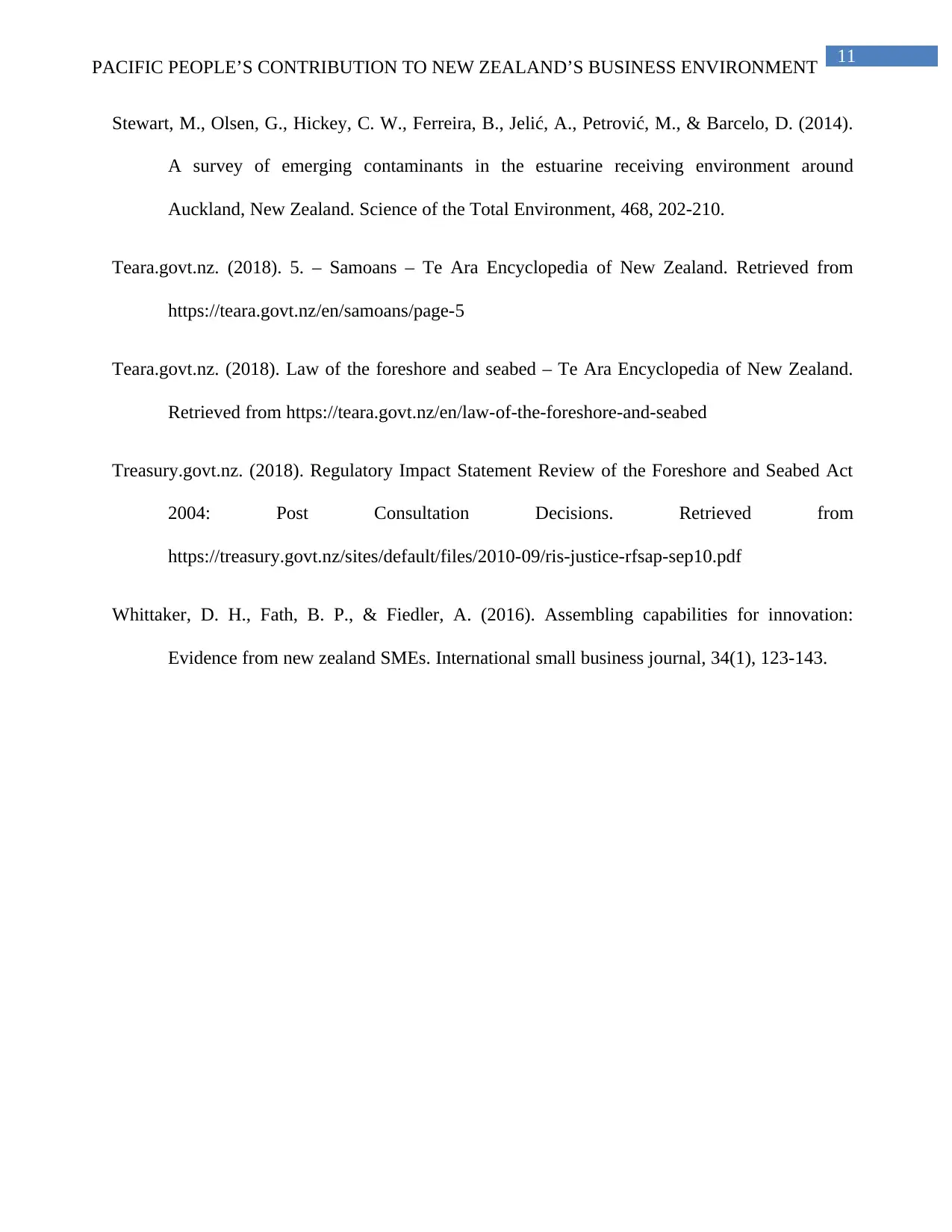
11
PACIFIC PEOPLE’S CONTRIBUTION TO NEW ZEALAND’S BUSINESS ENVIRONMENT
Stewart, M., Olsen, G., Hickey, C. W., Ferreira, B., Jelić, A., Petrović, M., & Barcelo, D. (2014).
A survey of emerging contaminants in the estuarine receiving environment around
Auckland, New Zealand. Science of the Total Environment, 468, 202-210.
Teara.govt.nz. (2018). 5. – Samoans – Te Ara Encyclopedia of New Zealand. Retrieved from
https://teara.govt.nz/en/samoans/page-5
Teara.govt.nz. (2018). Law of the foreshore and seabed – Te Ara Encyclopedia of New Zealand.
Retrieved from https://teara.govt.nz/en/law-of-the-foreshore-and-seabed
Treasury.govt.nz. (2018). Regulatory Impact Statement Review of the Foreshore and Seabed Act
2004: Post Consultation Decisions. Retrieved from
https://treasury.govt.nz/sites/default/files/2010-09/ris-justice-rfsap-sep10.pdf
Whittaker, D. H., Fath, B. P., & Fiedler, A. (2016). Assembling capabilities for innovation:
Evidence from new zealand SMEs. International small business journal, 34(1), 123-143.
PACIFIC PEOPLE’S CONTRIBUTION TO NEW ZEALAND’S BUSINESS ENVIRONMENT
Stewart, M., Olsen, G., Hickey, C. W., Ferreira, B., Jelić, A., Petrović, M., & Barcelo, D. (2014).
A survey of emerging contaminants in the estuarine receiving environment around
Auckland, New Zealand. Science of the Total Environment, 468, 202-210.
Teara.govt.nz. (2018). 5. – Samoans – Te Ara Encyclopedia of New Zealand. Retrieved from
https://teara.govt.nz/en/samoans/page-5
Teara.govt.nz. (2018). Law of the foreshore and seabed – Te Ara Encyclopedia of New Zealand.
Retrieved from https://teara.govt.nz/en/law-of-the-foreshore-and-seabed
Treasury.govt.nz. (2018). Regulatory Impact Statement Review of the Foreshore and Seabed Act
2004: Post Consultation Decisions. Retrieved from
https://treasury.govt.nz/sites/default/files/2010-09/ris-justice-rfsap-sep10.pdf
Whittaker, D. H., Fath, B. P., & Fiedler, A. (2016). Assembling capabilities for innovation:
Evidence from new zealand SMEs. International small business journal, 34(1), 123-143.
⊘ This is a preview!⊘
Do you want full access?
Subscribe today to unlock all pages.

Trusted by 1+ million students worldwide
1 out of 12
Related Documents
Your All-in-One AI-Powered Toolkit for Academic Success.
+13062052269
info@desklib.com
Available 24*7 on WhatsApp / Email
![[object Object]](/_next/static/media/star-bottom.7253800d.svg)
Unlock your academic potential
Copyright © 2020–2025 A2Z Services. All Rights Reserved. Developed and managed by ZUCOL.




